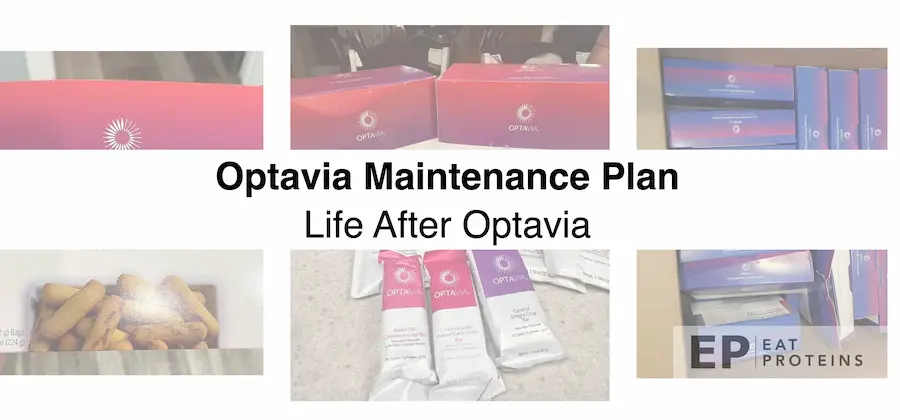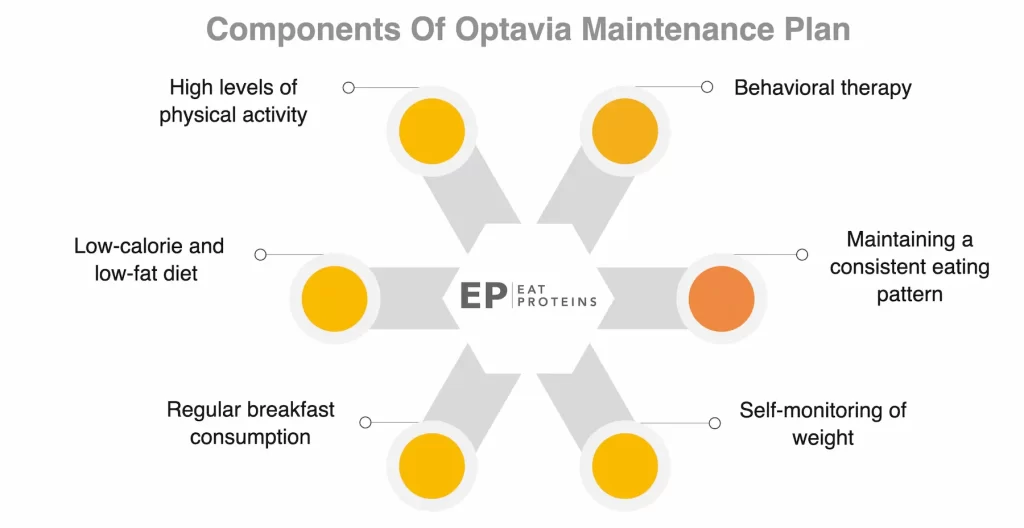
The Optavia Maintenance plan refers to a flexible eating plan designed to help you transition into a healthy and sustainable lifestyle after you finish the Optimal Weight 5 and 1 plan. It includes applying healthy habits, personalized coaching, and ongoing support to gradually transition from the weight loss phase into the weight maintenance phase.
According to a 2001 study titled “Successful weight loss maintenance” published in the Annual Review of Nutrition, it was estimated that more than 20% of overweight/obese individuals achieve long-term weight loss success. This indicates that approximately 80% of people are unable to sustain their weight loss in the long run.
The goal of the Optavia maintenance plan is to defy the prevailing odds against sustained weight loss, counteract these statistics, and improve the chances of long-term weight management success.
So if you recently completed the Optavia program and are wondering how to maintain your weight loss success, this article covers topics such as maintenance after Optavia, maintenance meal plans, and how much is the Optavia maintenance plan.
What Is Optavia Maintenance Plan?
The Optavia maintenance plan, also refers as Optimal Health 3 and 3 plan, is the final stage of the Optavia weight loss program, aimed at preserving the achieved weight loss results over an extended period.
It involves adopting behaviors that counteract physiological adaptations and other factors that may contribute to weight regain such as goal-setting, planning meals ahead of time, or avoiding eating late at night.
A 2015 study conducted by Dr. Frank L. Greenway from Louisiana State University revealed that following a low-calorie diet for weight loss, only 25% of individuals manage to sustain this weight loss in the long term. This means that most people end up gaining the weight back.
According to Dr. Greenway, Obesity is a complicated problem that involves both the body and the mind. Dr. Greenway states that the environment around us can make it harder to maintain a healthy weight.
Things like the food we see and eat, as well as our habits of sitting around a lot, can affect parts of our brain that control learning, pleasure, mood, and emotions. This can make us want to eat more even when we don’t need to.
What Is The Purpose Of The Optavia Maintenance Plan?
The purpose of the Optavia maintenance plan is to support individuals in maintaining a stable, long-term weight after undergoing a successful Optavia 5 and 1 weight-loss program.
Managing weight is crucial in tackling the widespread problem of weight regain, which can contribute to a range of health complications. While adopting Habits of Health and engaging in regular exercise are endorsed in the Optavia maintenance plan, maintaining the achieved weight becomes difficult due to physiological adjustments and environmental influences that favor weight regain.
In other words, it can be tough to keep the weight off as there are things in your surroundings that make it easy for you to gain weight again.
So, to manage your weight effectively, you need to think about how your body works, the environment you’re in, and the choices you make. Understanding all these things can help you find good ways to prevent and deal with obesity, which is when you’re very overweight.
What are the Components of the Optavia Maintenance Plan?
This graph shows various components of the Optavia maintenance plan, including high levels of physical activity, a low-calorie and low-fat diet, regular breakfast consumption, self-monitoring of weight, maintaining a consistent eating pattern, and utilizing behavioral therapy.

- High Levels of Physical Activity. While Optavia doesn’t encourage exercise during the 5 and 1 plan, according to their maintenance plan you should be doing regular exercises (e.g. playing sports). This can help you stay healthy and maintain your weight. It’s important to find activities that you enjoy and make them a regular part of your routine.
- Low-calorie and Low-Fat Diet. In the Optavia maintenance plan, you want to avoid foods that are high in calories and fats. At the same time, it’s about eating nutrient-dense foods that are good for your body, like fruits, vegetables, and whole grains, which can help you stay at a healthy weight.
- Regular breakfast consumption. A 2014 study by Emily J Dhurandhar from the University of Alabama at Birmingham suggests that eating a good breakfast every day is important for weight maintenance becasue it gives you energy and helps you control your appetite, so you don’t overeat later in the day.
- Self-monitoring of weight. A study conducted in 2013 by Ellinor K. Olander from Coventry University found that regularly monitoring one’s body weight is a helpful strategy for maintaining weight and preventing significant weight gain. This involves keeping track of progress and being aware of any changes in weight. By doing so, individuals can better manage their weight and make adjustments to their lifestyle as needed.
- Maintaining a consistent eating pattern. Establishing and sticking to a consistent eating pattern is highlighted as important for weight maintenance. This involves maintaining regular meal times and avoiding frequent disruptions to eating routines.
- Behavioral therapy. According to a 2015 meta-analysis of 61 studies published in the International Journal of Obesity, behavioral therapy is a key part of the management of obese individuals. These interventions aim to modify behaviors, thoughts, and attitudes related to food and physical activity to support long-term weight maintenance.
When we talk about maintaining weight, our behaviors and habits play a big role. That’s why the Optavia maintenance plan focuses on teaching us how to make good choices and develop healthy habits that will help us keep the weight off in the long term.
How Long Should I Stay on The Optavia Maintenance Plan?
The duration of the Optavia maintenance plan can vary depending on individual goals and circumstances. However, successful long-term weight loss maintenance is often defined as intentionally losing at least 10% of initial body weight and keeping it off for at least 1 year.
A 2001 study from the Annual Review of Nutrition suggests that individuals who achieve this level of weight loss and maintain it for several years significantly increase their chances of long-term success.
What is the Recommended Calorie Intake for the Optavia Maintenance Plan?
The recommended calorie intake for the Optavia Maintenance Plan varies depending on various factors, including age, gender, physical activity level, and individual body composition. Generally, the calorie range for the Optavia Maintenance Plan is between 1,200 and 2,500 calories per day.
How To Do Optavia Maintenance Plan?
To follow the Optavia maintenance plan, here are the steps you can take.
- Complete the Optavia 5 and 1 plan. This initial phase involves consuming five Optavia Fuelings and one lean and green meal per day to achieve your desired weight loss.
- Transition to the maintenance phase. After completing the 5 and 1 plan, enter the Optavia transition phase, which lasts for about six weeks. During this period, you gradually reintroduce more calories and food groups, such as grains, fruits, and starches, into your diet.
- Estimate your energy needs. Utilize the Optavia 3 and 3 calculators to determine how many calories you will need to maintain your weight. This calculation will provide guidance on the appropriate energy intake for you.
- Follow the Optimal Health 3 and 3 plan. This phase of the maintenance plan involves consuming three balanced meals and three Optavia Fuelings each day. Meal planning becomes essential, as you will be responsible for preparing and cooking three meals on your own. The remaining three Fuelings can be incorporated into your daily routine.
- Organize your grocery shopping list. Make a list of the foods you need to buy during your grocery shopping trips. Focus on selecting healthy, nutritious options that align with the Optavia maintenance guidelines.
- Stay active. Engage in physical activities that you enjoy to stay active. This can include exercises, sports, or any other form of movement that you find enjoyable and sustainable.
- Work with your coach. Maintain regular communication with your Optavia coach. They can provide support, help you troubleshoot any challenges you may encounter, and assist in identifying potential barriers to your success.
- Focus on stress reduction. Implement stress reduction techniques into your daily routine. This can include activities such as meditation, deep breathing exercises, or engaging in hobbies that help you relax and unwind.
How To Do Optavia Maintenance Plan Without A Coach?
To successfully follow the Optavia maintenance plan without a coach it’s a good idea to join a support group, track your progress, and include strength training exercises. Doing Optavia on your own means you have to rely on your own discipline and commitment.
This list shows you how to do Optavia maintenance on your own.
- Join a support group. Find a community of people who are also following the Optavia program or a similar maintenance plan. This will provide you with a supportive network of friends and family who can offer guidance and encouragement. Connect with at least 3-5 individuals who can offer support and guidance throughout your journey.
- Track your progress. Keep a food journal to record what you eat and drink each day. Aim to track your food intake for at least 5 days a week, noting portion sizes and any deviations from the Optavia plan. This will help you stay accountable and make adjustments if necessary.
- Include strength training exercises. Incorporate strength training exercises into your routine at least 2-3 times per week. Aim for 30-45 minutes per session, focusing on major muscle groups. Start with a weight that allows you to complete 8-12 repetitions with proper form.
- Stay active throughout the day. Strive to achieve at least 150 minutes of moderate-intensity aerobic activity or 75 minutes of vigorous-intensity activity per week. Break it down into smaller sessions of 20-30 minutes each day.
- Plan your lean and green meals in advance. Set aside time each week to plan your meals and snacks. Create a shopping list with Optavia Fuelings alternatives that can save you money and align with the program’s guidelines.
- Limit high-calorie, low-nutrient foods. Minimize your intake of foods that are high in calories but low in essential nutrients. This includes sugary snacks, processed foods, and beverages with added sugars.
- Be mindful when dining out. When eating out at restaurants, choose healthier options from the menu. Look for dishes that are grilled, steamed, or baked rather than fried. Control portion sizes and ask for dressings or sauces on the side.
What is the Price For the Optavia Maintenance Plan?
The cost of the Optavia maintenance plan is $485.10 per month. This price includes various components, such as 13 boxes of fuelings, 1 container of Optavia whey protein, and 2 boxes of Optavia Essential Amino Acids, providing a total of 181 servings.
The cost per fueling box is $23.25, and each box contains 7 servings.
It’s important to note that these prices are subject to change and may vary based on factors such as location and current promotions. It is recommended to consult with an Optavia representative or visit the official Optavia website for the most accurate and up-to-date pricing information.

